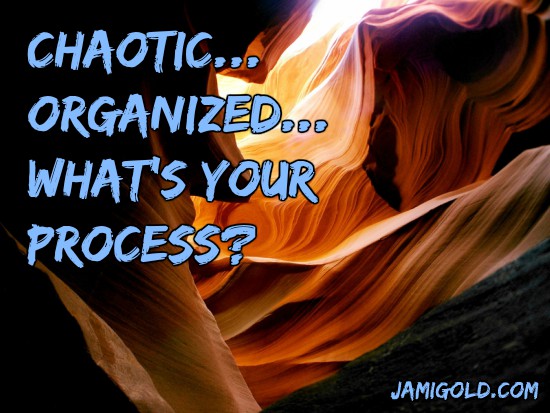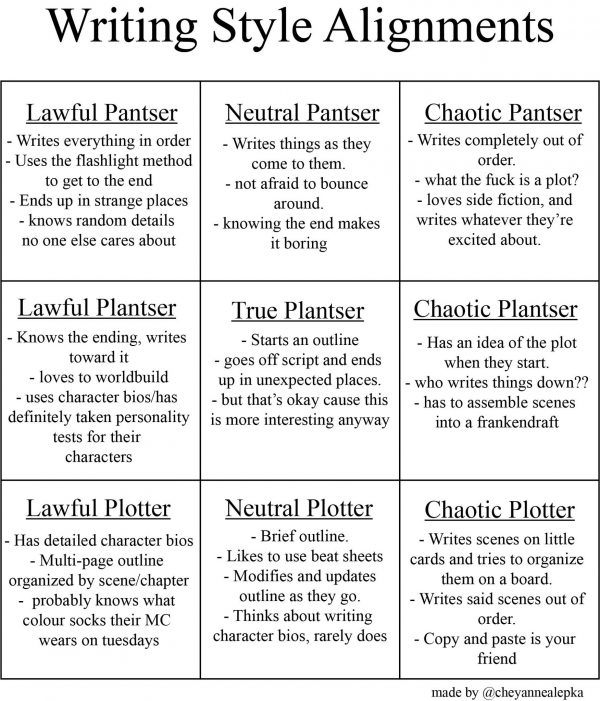Far too often in life, we look for ways to make the complex more understandable by simplifying the idea…maybe too much. Much of real life requires nuance and shades of gray to capture the true picture that our simplification can erase.
(That’s not a complaint or statement about shortcuts or laziness. That’s simply human nature. *grin*)
That truth can be found in the writing world as well. I’ve mentioned many times that I don’t believe there’s “one right way” or any “always applicable” rule for anything in writing.
My belief that there isn’t “one right way” is especially strong in regards to our drafting process. Each of us has unique strengths and weaknesses (experiences, background knowledge, brain processes, etc.)—not to mention our unique goals and life situations—that affects what drafting process will work best for us.
Yet to hear some authors talk, we might assume that there are strict plotters and strict pantsers (those who write by the seat of their pants) and nothing in between. Even more restrictive, the assumptions often are that every plotter uses beat sheets or scene cards and that every pantser has the same problems with random tangents and so on.
That’s why I loved a matrix Cheyanne A Lepka created and shared on Twitter. She found a way to point out how there’s no end to the mix of approaches we can use in our drafting.
Our Writing Process Is Unique
We are all different: what we notice, how we process information, what gets us stuck or unstuck, what motivates us, what helps us connect to our characters, etc. So the process we each use to successfully draft a story can all be different as well.
Just looking at the realm of drafting, we might experiment with many different approaches, such as:
- using a story seed of a plot or a character or a theme or a premise or a turning point scene or a first line, etc.
- outlining in advance vs. beat sheets vs. pantsing (or anything in between)
- writing linearly vs. jumping from scene to scene
- focusing only on dialogue (or whatever) in the first draft vs. writing a fully layered draft
- thinking of each scene as a short story (beginning to end and an arc of change) vs. keeping the threads of the overall story in mind
- editing as we go vs. only going forward during drafting
- fast-drafting vs. taking as long as we need
- knowing how the story’s going to end ahead of time vs. figuring it out when we get there
- drafting in “telling” mode and adding “showing” details later
- writing one character’s point of view first and then mixing in the other POV scenes
The process that works for someone who wants write plot-focused stories and lives on their own with no kids underfoot is likely to be very different from the process that works for someone who wants to write character-focused family sagas and has to squeeze in words between a houseful’s worth of loads of laundry and caring for an ailing parent.
Our Writing Process Matters Only to Us
None of those bullet choices above could be labeled “right” or “wrong.” None of them would prevent us from putting finished stories in the hands of our readers. And isn’t that really the point?
Our writing process doesn't prevent the ability to finish with a quality book. Click To TweetReaders can’t tell from reading a story whether it was pantsed or plotted. Or whether we tore our hair out with writer’s block for 3 months in the middle of drafting it. Or whether we *gasp* edited as we drafted.
That’s because none of that affects our ability to end up with a quality book. Readers don’t see the sausage-making, only the sausage itself. As long as that sausage is yummy, they don’t care about our process. The only difference between the options is whether they work for us.
Writing Style Alignments
When it comes to the typical two-answer pantser vs. plotter division, the matrix Cheyanne A Lepka created instead includes 9 writing “alignments” in the style of tabletop gaming characters. With role-playing characters, the traditional matrix charts the two axes of Lawful/Neutral/Chaotic and Good/Neutral/Evil:
| Lawful Good | Neutral Good | Chaotic Good |
| Lawful Neutral | Neutral | Chaotic Neutral |
| Lawful Evil | Neutral Evil | Chaotic Evil |
In Cheyanne’s reimagining for our writing process, she used Lawful/Neutral/Chaotic and Pantser/Plantser/Plotter. (The term plantser is often used to describe an in-between approach.)
| Lawful Pantser | Neutral Pantser | Chaotic Pantser |
| Lawful Plantser | Neutral Plantser | Chaotic Plantser |
| Lawful Plotter | Neutral Plotter | Chaotic Plotter |
Already with those 9 drafting styles, there’s more nuance than just the two basics of pantser or plotter. But Cheyanne takes it a step further to encourage writers to combine those 9 categories as well.
Ooops, I made a thing. Tell me your alignment. ??
PS. if it’s a mix, great, tell me that.
PPS. This is meant to be fun, don’t get salty.#writingcommunity #amwriting #turtlewriters pic.twitter.com/9PDgmTwBCI— Cheyanne A Lepka (@cheyannealepka) May 12, 2019
Our Alignment Can Change
Obviously, just because something works for us one time doesn’t mean it will work for us all the time. Our process might evolve with more experience, or adjust as our situation, our mood, or our connection with the story itself changes.
In addition, we can expand on that idea by understanding that we might use a different alignment combination for every story. The characters in some stories might encourage us to follow their lead more than usual. Or a deadline for a different story might necessitate a frankendraft as we squeeze in a thousand words here and there whenever we have time to draft.
Again, there’s no wrong approach—and no wrong combination—as long as it works for us. Rather than the pantser-plotter dichotomy, think of it as more of a spectrum of infinite possibilities. *smile*
Do You Know Your Alignment Combination?
So what’s your writing style alignment—or alignment combination?
(Click image to view larger or click here to view Cheyanne’s original post. Newsletter readers, click through to the post to see images.)
Personally, depending on the story, I’m a mix of various Pantser and Plantser alignments. I’m closest to a Lawful Pantser, as every detail in that alignment applies to me. (Flashlight—or headlight—method refers to only seeing details right in front of us as we’re typing.)
Did you see the Writing Style Alignment chart from @cheyannealepka? What's your style? Click To TweetHowever, I also often throw in elements from Lawful Plantser and Chaotic Plantser. (Because…why not?) But never anything from the Plotter side of the chart until editing time—yeeks. *grin*
I don’t use the character bios or personality tests of the Lawful Plantser side, but I think about worldbuilding a lot before writing a word, and I’ll sometimes know(ish) the ending. (Um, I write romance, so it’s a Happily Ever After? Ta-da!)
Unlike the Chaotic Plantser, I don’t write frankendrafts or out of order at all because, for me, developing a character organically requires me to discover them over the course of the story. But I often have vague ideas of some of the big turning points, yet don’t write anything down so as not to pressure my muse to stick to a certain plan.
Of course the actual mix doesn’t matter. But I think Cheyanne’s examples are great for getting us to think about how our process works—or doesn’t work—for us.
The better we understand ourselves and our process, the more we might be able to adjust when we get stuck. If I’m not getting a good handle on my characters, I could try taking a personality test for them and so forth.
The point is that we never want to feel like we’re “doing it wrong” or that we have to squish ourselves into a process-box that doesn’t fit. With the many combinations of these 9 alignments, I hope we can see that—just with this one perspective, not to mention all the other ways of looking at the spectrum—we can find a process that works just right for us. *smile*
Have you seen references to plotters and pantsers that disregards anything in between? Do you think it’s more of a spectrum between those extremes? Has your process changed over time (and if so, how)? Does it change from one story to another? Where do you fall on the alignment chart?


